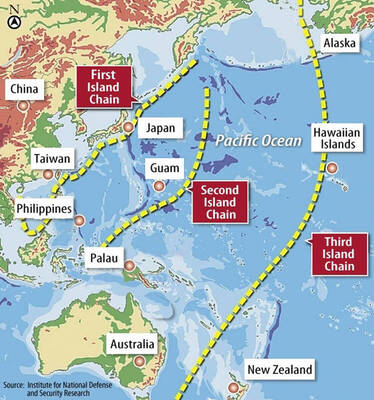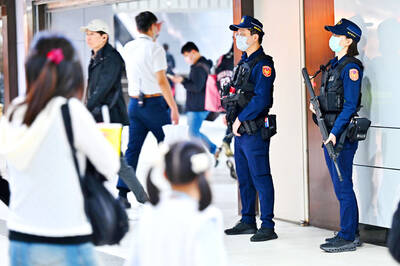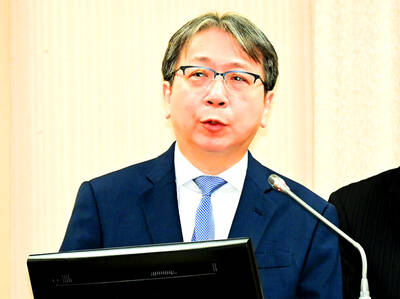An upgrade of the nation’s fleet of F-16 jets began yesterday, with four of the aircraft flown to a plant in Taichung to undergo retrofitting, the air force said yesterday.
The four warplanes are the first batch to be upgraded to F-16Vs, an enhanced variant of the F-16A/B, of which the nation has a fleet of 144.
The NT$110 billion (US$3.47 billion) Phoenix Rising Project aims to upgrade all the F-16A/Bs to F-16Vs.
Taiwan is to be the first nation worldwide to have a fleet of F-16Vs, which Minister of National Defense Feng Shih-kuan (馮世寬) said could match China’s Chengdu J-20 stealth fighter.
Aerospace Industrial Development Corp (AIDC) and US aerospace firm Lockheed Martin Corp, the original producer of F-16s, were awarded the contract to carry out the upgrades.
Lockheed Martin in 2015 completed the upgrade and test flight of an F-16 owned by Taiwan but stationed at a US Air Force base.
AIDC is responsible for carrying out the retrofitting program in Taiwan, with the first four F-16Vs expected to be upgraded by the end of this year.
The firm refused to disclose the upgrade schedule in detail due to its agreement with Lockheed Martin.
According to Republic of China Air Force Chief of Staff Lieutenant General Fan Ta-wei’s (范大維) statement at a legislative session in November last year, AIDC is to complete the upgrade of 25 to 28 F-16s every year and the air force’s entire fleet — including 10 F-16s stationed at a US base — will be upgraded by 2023.
The upgraded aircraft are to be fitted with active electronically scanned array fire-control radar — the most important feature of the upgrade — which enables F-16Vs to detect stealth aircraft.
The F-16Vs are also to be equipped with advanced avionics, including a new flight management system and helmet-mounted display system, and the upgraded jets would carry more advanced missiles, such as AIM-9X Sidewinders.
With a radar system on a par with those of fifth-generation fighters, the F-16Vs are expected to shoulder the nation’s air defense for the next two decades.

The US government has signed defense cooperation agreements with Japan and the Philippines to boost the deterrence capabilities of countries in the first island chain, a report by the National Security Bureau (NSB) showed. The main countries on the first island chain include the two nations and Taiwan. The bureau is to present the report at a meeting of the legislature’s Foreign Affairs and National Defense Committee tomorrow. The US military has deployed Typhon missile systems to Japan’s Yamaguchi Prefecture and Zambales province in the Philippines during their joint military exercises. It has also installed NMESIS anti-ship systems in Japan’s Okinawa

TRAGEDY STRIKES TAIPEI: The suspect died after falling off a building after he threw smoke grenades into Taipei Main Station and went on a killing spree in Zhongshan A 27-year-old suspect allegedly threw smoke grenades in Taipei Main Station and then proceeded to Zhongshan MRT Station in a random killing spree that resulted in the death of the suspect and two other civilians, and seven injured, including one in critical condition, as of press time last night. The suspect, identified as a man surnamed Chang Wen (張文), allegedly began the attack at Taipei Main Station, the Taipei Fire Department said, adding that it received a report at 5:24pm that smoke grenades had been thrown in the station. One man in his 50s was rushed to hospital after a cardiac arrest

PUBLIC SAFETY: The premier said that security would be tightened in transport hubs, while President Lai commended the public for their bravery The government is to deploy more police, including rapid response units, in crowded public areas to ensure a swift response to any threats, President William Lai (賴清德) said yesterday after a knife attack killed three people and injured 11 in Taipei the previous day. Lai made the remarks following a briefing by the National Police Agency on the progress of the investigation, saying that the attack underscored the importance of cooperation in public security between the central and local governments. The attack unfolded in the early evening on Friday around Taipei Main Station’s M7 exit and later near the Taipei MRT’s Zhongshan

ON ALERT: Taiwan’s partners would issue warnings if China attempted to use Interpol to target Taiwanese, and the global body has mechanisms to prevent it, an official said China has stationed two to four people specializing in Taiwan affairs at its embassies in several democratic countries to monitor and harass Taiwanese, actions that the host nations would not tolerate, National Security Bureau (NSB) Director-General Tsai Ming-yen (蔡明彥) said yesterday. Tsai made the comments at a meeting of the legislature’s Foreign Affairs and National Defense Committee, which asked him and Minister of National Defense Wellington Koo (顧立雄) to report on potential conflicts in the Taiwan Strait and military preparedness. Democratic Progressive Party (DPP) Legislator Michelle Lin (林楚茵) expressed concern that Beijing has posted personnel from China’s Taiwan Affairs Office to its